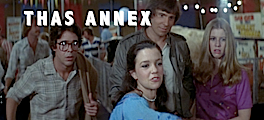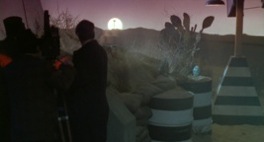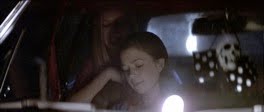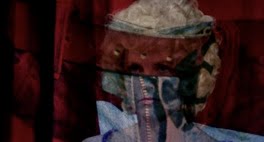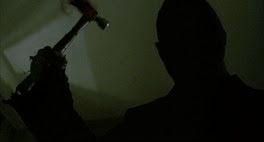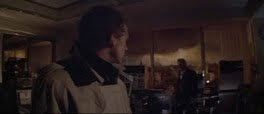Hooper is a "folksier" kind of filmmaker in the sense that his most striking formal gestures only depend on components of cinema at their most basic and subdued: space to be plainly rendered, time to be also, and the plain presence of a grounded camera. He does not quite rock montage theory or art-house cliches as other filmmakers do, but the minimal excesses that his style employs - driven by very traditional harmonies and not amped-up power chords of evolving style - endows his tenderly wrought ideas of camera form, his floating mise en scene, and his awareness of sublime textures, with the beauty-centric purity of purpose of, sure, a solemn country hymn.
Odd as it may seem to say about the maker of The Texas Chain Saw Massacre, it is the positivity of his work, the humble good-nature of his career, and the clearness of his aesthetic purposes that set him apart from an industry of comparable filmmakers. Hooper's self-declared gentle nature shows in his very film choices. I feel it is reasonable to presume, for the purposes of now, that Hooper has never directed for the "sexiness" of the medium. We can safely say that, for instance, he has never made a "guy movie" - an action film of that kind that trades in bad-ass fight scenes and testosterone-raising levels of violence, swagger, and weaponry. Despite being a maker of ostensible slasher films, never do his works bypass a generous emotional element, and never has he given us one cold or blasé, or totally juvenile and ruthlessly exploitative. It suggests Hooper never takes on a project he does not feel, in some way, will reflect his nature, or that he cannot treat feelingly in some way. By that virtue alone, not even his most frivolous film should be deemed frivolous, treated as they are with this utmost positive artistic investment. It is in the way his craft is devoted not to genre, nor story, nor entertainment or thrills, but only to serious-minded aesthetic - a formula-free, symphony-aimed camera form, and one that I feel is especially adept towards the soulful, the abstract, the emotional (i.e. compassionate), and the richly meaningful. This - not genre, or surreal lighting, or his depraved families - is the most accurate Hooperian auteurist stamp.
This viewpoint has particular application with regards to his 2000s works, Toolbox Murders and Mortuary, both seemingly representations of the dregs of a career: low-budget DTV bargain bin horror fodder, schlocky body count films written with all the banal trappings of slasher killers, zombie carnage, and other promises of horror exploitation. Yet, with my odds on Hooper the artist, both films always strike me as highly worthy entries in an artisan's catalog, and the amount of delicate craft and textural, humane sensitivities of Hooper's variety that is packed into what by all means should be crass and artless works speaks of what a bottom-line there is to Hooper when making films, the bottom-line being it is an art, it is aesthetic expression, and as such it ought always to inspire grace and many notions of grace as often as it can throughout its running time.
With Mortuary (as with Toolbox Murders), Hooper works against (or with) the weightlessness of the material through a carefree investment in creating characters and situations instilled with warmth, amiability, joie de vivre, and any assorted uncharacteristic [undesirable] traits in horror films, to set his films apart from the usual ones that trade in cold emptiness, lurid atmospherics, exploitative set-ups, etc. - the "sickly-sensational slasher misanthropy" termed in my previous 'Toolbox Murders' post. Mortuary paints an, if not deep, an uninhibitedly fond portrait of a completely likable, completely down-to-earth family unit, consisting of a scatter-brained but well-intentioned mother (Denise Crosby), a perfectly unpretentious little girl, and a slightly disaffected but otherwise perfectly caring teenage son (Dan Byrd).
Mortuary is not a good film. When it comes down to it, it is a bad DTV horror movie with a horrendous screenplay. But I do love it, meaning I thoroughly enjoy it, of course mainly due to Hooper's idiosyncratic visual eye, resonant acquisitions of cinematography (by DP Jaron Presant; the film really is a good-looking picture, even a step up from the crude gothic of Toolbox Murders with its Halloween party colors), and directorial delicacy, which lends the film its amiable energy and gentle textures. Yes, Mortuary may be dumb as nails, and progressively more embarrassing as it goes on, but as all Hooper's films, it is still deserving of a fine stylistic combing-through.
Images from the First 20 Minutes of MORTUARY, Pt. 1
Blocking
Hooper's blocking is as alive and deliberately captured as ever, and it results in a picture that manages to make straight-forward scene coverage vivid and vital. A few things to notice are the way he has bodies populate his frame, how they arrange themselves in his mise en scene in precise, composed ways, how Hooper and his editor make the blocking absolutely integral to their construction, and the way Hooper loves the all-inclusive shot, here consistently accounting for off-screen bodies by consistently including them at the edges of the frame (in constant "dirty" framing, to use cinematographer-speak):


And pocked all throughout, used to marked effect, a buoyant, perceptive mixture of
two-shots
Patience of Storytelling
This textured, attentive and continuity-driven handling of bodies in the frame is continued through to the following scenes in Mortuary.





(Denise Crosby's mother pokes her hands back into the frame to fetch her daughter: a visually offbeat, endearing disembodiment created by Hooper's frame.)

In the Kitchen







(Even an insert of a sink being turned on is given extra-textural treatment, with the character's entire arm filling the frame before pulling back and revealing his act of turning the faucet on.)



In the Parlor

(Shallow focus texture tenderly introduced and maintained throughout this parlor scene.)
Patient Storytelling
This detail to movement and spatial interrelation not only generates elegance and a graceful naturalism, but it works to all together create a pace for the picture. This opening portion of Mortuary - of four characters mingling together, inhabiting various spaces together - surprises by all together characterizing this low-budget horror film with a very uncharacteristic patience of storytelling, wholly elegant and non-bombastic, tenderly attentive to the minuteness of interaction and of interiority. It's no surprise, then, when Hooper slows things down even further when the narrative breaks away from the group of four to follow the solitary motions of the little girl, slipping away to embark on a bit of solo exploration.


What makes this moment astounding, though, is that Hooper follows it with an almost identical moment not long afterwards, that follows the teenage brother as he quietly slips away from the group (a striking mirror moment, and at the point the little sister's solitary venture is cut short) and goes on his own bit of wandering self-exploration:












































































